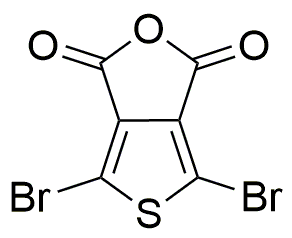2,5-Dibromo-3,4-thiophenedicarboxylic anhydride is widely utilized in research focused on:
- Organic Electronics: This compound serves as a key building block in the synthesis of organic semiconductors, which are essential for developing flexible electronics and organic photovoltaic cells.
- Polymer Chemistry: It is used to create functionalized polymers that exhibit enhanced thermal and electrical properties, making it valuable in the production of advanced materials for coatings and adhesives.
- Pharmaceutical Development: The compound plays a role in the synthesis of bioactive molecules, contributing to drug discovery processes, particularly in developing new therapeutic agents.
- Environmental Applications: Its derivatives are explored for use in sensors and materials that can detect and remediate environmental pollutants, addressing critical challenges in environmental science.
- Research in Material Science: The compound is studied for its potential in creating novel materials with unique optical and electronic properties, which can lead to innovations in various high-tech applications.
Información general
Propiedades
Seguridad y normativas
Aplicaciones
2,5-Dibromo-3,4-thiophenedicarboxylic anhydride is widely utilized in research focused on:
- Organic Electronics: This compound serves as a key building block in the synthesis of organic semiconductors, which are essential for developing flexible electronics and organic photovoltaic cells.
- Polymer Chemistry: It is used to create functionalized polymers that exhibit enhanced thermal and electrical properties, making it valuable in the production of advanced materials for coatings and adhesives.
- Pharmaceutical Development: The compound plays a role in the synthesis of bioactive molecules, contributing to drug discovery processes, particularly in developing new therapeutic agents.
- Environmental Applications: Its derivatives are explored for use in sensors and materials that can detect and remediate environmental pollutants, addressing critical challenges in environmental science.
- Research in Material Science: The compound is studied for its potential in creating novel materials with unique optical and electronic properties, which can lead to innovations in various high-tech applications.
Documentos
Hojas de datos de seguridad (HDS)
La SDS proporciona información de seguridad completa sobre la manipulación, el almacenamiento y la eliminación del producto.
Especificación del producto (PS)
La PS proporciona un desglose completo de las propiedades del producto, incluida la composición química, el estado físico, la pureza y los requisitos de almacenamiento. También detalla los rangos de calidad aceptables y las aplicaciones previstas del producto.
Certificados de análisis (COA)
Busque certificados de análisis (COA) ingresando el número de lote del producto. Los números de lote y de partida se pueden encontrar en la etiqueta de un producto después de las palabras "Lote" o "Lote".
Número de catálogo
Número de lote/lote
Certificados de origen (COO)
Este certificado de origen confirma el país en el que se fabricó el producto y también detalla los materiales y componentes utilizados en él y si se deriva de fuentes naturales, sintéticas u otras fuentes específicas. Este certificado puede ser necesario para cumplir con las normativas aduaneras, comerciales y regulatorias.
Número de catálogo
Número de lote/lote
Hojas de datos de seguridad (HDS)
La SDS proporciona información de seguridad completa sobre la manipulación, el almacenamiento y la eliminación del producto.
DownloadEspecificación del producto (PS)
La PS proporciona un desglose completo de las propiedades del producto, incluida la composición química, el estado físico, la pureza y los requisitos de almacenamiento. También detalla los rangos de calidad aceptables y las aplicaciones previstas del producto.
DownloadCertificados de análisis (COA)
Busque certificados de análisis (COA) ingresando el número de lote del producto. Los números de lote y de partida se pueden encontrar en la etiqueta de un producto después de las palabras "Lote" o "Lote".
Número de catálogo
Número de lote/lote
Certificados de origen (COO)
Este certificado de origen confirma el país en el que se fabricó el producto y también detalla los materiales y componentes utilizados en él y si se deriva de fuentes naturales, sintéticas u otras fuentes específicas. Este certificado puede ser necesario para cumplir con las normativas aduaneras, comerciales y regulatorias.


